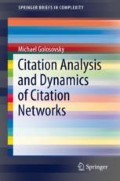Abstract
We explain what is citation analysis and which role it plays in the research of power-law statistical distributions, complex networks, and bibliometrics.
Access this chapter
Tax calculation will be finalised at checkout
Purchases are for personal use only
References
Auerbach, F. (1913). Das Gesetz der Bevölkerungskonzentration. Petermanns Geographische Mittelungen 59, 74–76.
Bar-Ilan, J. (2008). Informetrics at the beginning of the 21st century–a review. Journal of Informetrics, 2(1), 1–52.
Barabasi, A. L. (2015). Network science. Cambridge: Cambridge University Press.
Barabasi, A. L., & Albert R. (1999). Emergence of scaling in random networks. Science, 286(5439), 509–512.
Bradford, S. C. (1934). Sources of information on specific subjects, Engineering: An Illustrated Weekly Journal (London), 137, 85–86. Reprinted as: Bradford, S. C. (1985). Sources of information on specific subjects. Journal of Information Science, 10(4), 176–180.
Clauset, A., Shalizi, C., & Newman, M. (2009). Power-law distributions in empirical data. SIAM Review, 51(4), 661–703.
Condon, E. U. (1928). Statistics of vocabulary. Science, 67(1733), 300.
de Solla Price, D. J. (1965). Networks of scientific papers. Science, 149(3683), 510–515.
Fortunato, S., Bergstrom, C. T., Börner, K., Evans, J. A., Helbing, D., Milojević, S., et al. (2018). Science of science. Science, 359(6379), eaao0185.
Garfield, E. (1998). Random thoughts on citationology its theory, & practice. Scientometrics, 43(1), 69–76.
Hirsch, J. E. (2005). An index to quantify an individual’s scientific research output. Proceedings of the National Academy of Sciences, 102(46), 16569–16572.
Huberman, B. A., & Adamic, L. A. (1999). Evolutionary dynamics of the World Wide Web. Preprint arXiv:cond-mat/9901071.
Lotka, A. J. (1926). The frequency distribution of scientific productivity. Journal of the Washington Academy of Sciences, 16(11), 317–323.
Mingers, J., & Leydesdorff, L. (2015). A review of theory, & practice in scientometrics. European Journal of Operational Research, 246(1), 1–19.
Moed, H. F. (2005). Citation analysis in research evaluation. Berlin: Springer.
Pareto, V. (1909). Manuel d’economie politique. Paris: Giard & Briére.
Price, D. D. S. (1976). A general theory of bibliometric and other cumulative advantage processes. Journal of the American Society for Information Science, 27(5), 292–306.
Redner, S. (1998). How popular is your paper? An empirical study of the citation distribution. The European Physical Journal B, 4(2), 131–134.
Scharnhorst, A., Börner, K., & van den Besselaar, P. A. A. (2012). Models of science dynamics; Encounters between complexity theory and information sciences. Understanding complex systems. Berlin: Springer.
Shockley, W. (1957). On the statistics of individual variations of productivity in research laboratories. Proceedings of the IRE, 45(3), 279–290.
Sinatra, R., Deville, P., Szell, M., Wang, D., & Barabsi, A. L. (2015). A century of physics. Nature Physics, 11:791.
Small, H. (1973). Co-citation in the scientific literature: A new measure of the relationship between two documents. Journal of the American Society for information Science, 24(4), 265–269.
Sugimoto, C. R., & Cronin, B. (2014). Beyond bibliometrics: Harnessing multidimensional indicators of scholarly impact. Cambridge: The MIT Press.
Waltman, L. (2016). A review of the literature on citation impact indicators. Journal of Informetrics, 10(2), 365–391.
Wang, D., Song, C., & Barabsi, A. L. (2013). Quantifying long-term scientific impact. Science, 342(6154), 127–132.
Zener, C. (1968). An analysis of scientific productivity. Proceedings of the National Academy of Sciences of the United States of America, 59(4), 1078–1081.
Zeng, A., Shen, Z., Zhou, J., Wu, J., Fan, Y., Wang, Y., & Stanley, H. E. (2017). The science of science: From the perspective of complex systems. Physics Reports, 714–715, 1–73.
Zipf, G. K. (1949) Human behaviour and the principle of least effort. Reading, MA: Addison-Wesley.
Author information
Authors and Affiliations
Rights and permissions
Copyright information
© 2019 The Author(s), under exclusive license to Springer Nature Switzerland AG
About this chapter
Cite this chapter
Golosovsky, M. (2019). Introduction. In: Citation Analysis and Dynamics of Citation Networks. SpringerBriefs in Complexity. Springer, Cham. https://doi.org/10.1007/978-3-030-28169-4_1
Download citation
DOI: https://doi.org/10.1007/978-3-030-28169-4_1
Published:
Publisher Name: Springer, Cham
Print ISBN: 978-3-030-28168-7
Online ISBN: 978-3-030-28169-4
eBook Packages: Physics and AstronomyPhysics and Astronomy (R0)

